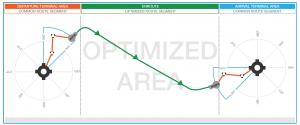Ryan Frankhouser, UAS Regional Director, Americas, demonstrates flightevolution™, UAS’ new flight planning tool, at EBACE 2016.
To effectively optimize a flight plan, the airborne portion of the route is divided into the three distinct segments. The Departure Terminal Area, which is defined as the area between the runway and the edge of the departure terminal area, referred to as the “Pitch” point. The Arrival Terminal Area, which is defined as the area between the edge of the arriving terminal area, referred to as the “Catch” point, and the runway.
The area in between the Pitch and Catch points is the Enroute Area, which is where we spend the most time talking about optimization. (Let’s count this area out for the purpose of this blog.)

The Departure Terminal Area and the Arrival Terminal Area contain “Common Route Segments,” meaning, air traffic is typically routed through one of many standard (common) routing protocols, regardless of whether they are published as procedures or not.
Air Traffic Control (ATC) uses these common segments to streamline traffic flows, increase efficiency, and minimize deviations. Although these common routes might not be truly optimal, they are fairly optimized in the eyes of ATC. We must resist the urge to file a flight plan that openly optimizes the portion of the route within these two segments. Chances are, if you try to file a route that is not what ATC perceives to be in the best interest of themselves or other traffic, you will receive an amended clearance, or worse, the dreaded Full Route Clearance (FRC), which will leave you scrambling to update your flight plans, FMS, charts, and the like. The true optimization takes place between the Pitch and Catch points of the route. And what happens when there are no “common” routes? We optimize!
For more in-depth information on the three segments of flight and the algorithms used to build optimized routing, download our technical white paper, The Basics of Flight Plan Optimization, which is available here https://www.uas.aero/the-basics-of-flight-plan-optimization





